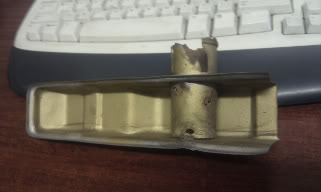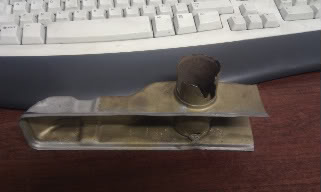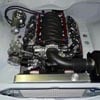Does a alloy radiator need to be insulated when mounted?
#1
 _Viper_
_Viper_
Posted 27 July 2011 - 06:29 PM
Think it was bought up about dis-similar metals touching.... But what about Alloy heads on Iron blocks? Yes I know there is a head gasket but the head bolts are are steel...
And if the Radiator is completely insulated then my thermo fans would not work because they are switched on by the temp sender which is screwed into the radiator and earths through the radiator and into the body?
Then you also have the water running through the block and the radiator, Does the water not have the capacity to carry stray current?
So yea, clarify?
#2

Posted 27 July 2011 - 06:40 PM
#3
 _Viper_
_Viper_
Posted 27 July 2011 - 06:42 PM
#4

Posted 27 July 2011 - 06:49 PM
#5

Posted 27 July 2011 - 06:51 PM
#6
 _Viper_
_Viper_
Posted 27 July 2011 - 06:53 PM
Maybe just drill the holes larger and fit a rubber wiring grommet in the mounting holes?
But in saying that your engine bay should be painted so it would be alloy contacting paint? not bare steel
#7
 _L32M20_
_L32M20_
Posted 27 July 2011 - 07:08 PM
#8
 _1uzbt1_
_1uzbt1_
Posted 27 July 2011 - 07:53 PM
Use a two pin switch for the fans instead
#9
 _hutch_
_hutch_
Posted 27 July 2011 - 08:10 PM
Phillip
#10

Posted 27 July 2011 - 09:05 PM
#11

Posted 27 July 2011 - 10:22 PM
Some tech articles recommend grounding the radiator to reduce electrolysis and others recommend you do not ground the radiator. There seems to be more support for grounding the radiator.
They all agree that you must use appropriate coolant and test for stray current regularly using a multimeter (see Nulon document ) or dedicated device (Koolit Indicator). Apparently brass/copper radiators are also susceptible to stray current corrosion.
Nulon Facts Sheet
So, why are we seeing more stray current related radiator failures these days? A good example of how modern radiators are so vulnerable to stray current corrosion is that many of them are attached to the vehicle by their plastic tanks, or are insulated from the vehicle chassis by rubber mounts.
Radiator Reporter Electrolysis
Take electrolysis, for example. Before the days of front wheel drive and transverse-mounted engines, cooling system electrolysis was a rare occurrence. But today, with most cars and many light-duty trucks featuring electric cooling fans in conjunction with ungrounded plastic-tank radiators, cooling system electrolysis is becoming a frequent problem.
Birds Radiators
Early on, when electrolysis first cropped up as a problem in cooling systems, many mechanics attempted to solve the problem by grounding the heater or radiator in order to "collect" any stray voltage and route it to battery ground. But mechanics soon discovered that grounding a heat exchanger to "collect" stray current merely accelerated the damage to the heat exchanger.
KOOL-IT® Electrolysis Indicator
Edited by ls2lxhatch, 27 July 2011 - 10:25 PM.
#13
 _Leakey_
_Leakey_
Posted 28 July 2011 - 08:01 AM
Seriously though, yes you need to insulate it, and use earth straps/wires to your fans.
#14
 _Viper_
_Viper_
Posted 28 July 2011 - 08:15 AM
Is it just a very slow process and slowly eats away at the alloy?
#15
 _1uzbt1_
_1uzbt1_
Posted 28 July 2011 - 10:02 AM
In all honesty if seen very few that are actual stray current issues, mostly are mixed coolant corrosion issues and then people blame stary cuurent. Stary current blackens header plates inside the rad and have a white powder visable inside the fittings, far easier to see on a black plastic tank.
If you dont have a stray current issue i see it making no difference either way but i would still rubber mount if possible.
#16

Posted 28 July 2011 - 11:10 AM
If you are running good coolant and there are no faults in your wiring or electrical equipment then electrolysis should not be a problem. If you mix coolant types or there are faults in your wiring then you are going to have electrolysis problems regardless of how the radiators is mounted.
I would just mount the radiator normally. Run quality coolant that you change according to the manufactures specifications.
When you first put the car back together the fill the radiator with coolant and leave the car with the battery disconnected for 24 hours. After 24 hours check the coolant voltage to make sure it is zero. Then connect the battery, turn everything electrical on and check the coolant for stray current using either a analog multi meter or the Kool-it electrolysis indicator.
#17
 _Viper_
_Viper_
Posted 28 July 2011 - 01:39 PM
#18
 _1uzbt1_
_1uzbt1_
Posted 28 July 2011 - 02:08 PM
Nulon and Radiator Reporter blame rubber mounting and plastic tanks (insulating the radiator) for the increase in electrolysis problems. Brass/copper radiators are apparently even more susceptible to electrolysis than aluminium radiators therefore there are no special mounting requirements in terms of electrolysis for aluminium radiators.
Other way around, ive seen ally rads fail in less than a week due to bad install. copper/brass will last a hell of a lot longer if abused.
I changed a ally rad to copper brass one and what i didnt know it had a wiring issue (12v wire directly on radiator bands which are rubber mounted). The fact that the ally core was isolated to the 12v due to plastic tanks it was all right and it was the failure of the plastic resulting in change over. The new copper/brass was fitted and then 3 mnths later completely chewed out.
this is it here.


Edited by 1uzbt1, 28 July 2011 - 02:08 PM.
#19

Posted 28 July 2011 - 02:50 PM
Any issue were always fixed asap.
These motors have 2 water outlets facing up at the front of the engine.
These are connected to the radiator via a 90 degree cast alloy bend with some hose either end of the bend.
The bend were 5-6mm thick but this didn't stop them being eaten out (3 within 12monthes)
After running an Earth wire to each bend & inspecting them later, we found it had 99% cured it!
#20

Posted 29 July 2011 - 03:18 AM
Does it have to be a analog multimeter?
According to Nulon a digital multimeter's is not suitable.
Switch a multimeter to a scale of 5 volts DC or less. Ideally the meter should be capable of reading millivolts.
Do not use a digital multimeter, as its internal operating characteristics are not suitable for this test.
There seems to be as many companies claiming that aluminium is less susceptible to electrolysis as there are claiming brass/copper is less susceptible to electrolysis.
Aluminium radiators are not easily affected by corrosion including electrolytic corrosion.
Copper vs aluminium
#21

Posted 29 July 2011 - 08:12 AM
#22
 _1uzbt1_
_1uzbt1_
Posted 29 July 2011 - 11:29 AM
Ally can be real hard to repair as it oxidises, which melts 3 times higher than the melting point of the ally itself. It has to be spotless to repair where as brass is easily clean with hydrocloric(spelling) acid.
#23
 _bunkerjest_
_bunkerjest_
Posted 30 July 2011 - 10:19 PM
#24
 _Bomber Watson_
_Bomber Watson_
Posted 30 July 2011 - 10:32 PM
And how do we rectify the problem if it occurs???
Lots of talk of this that and bla bla, but very little actual useable info for people new to this kinda thing.
Cheers.
Edited by Bomber Watson, 30 July 2011 - 10:36 PM.
#25
 _1uzbt1_
_1uzbt1_
Posted 30 July 2011 - 11:13 PM
Ideally you are supposed to do it with out coolant in the system.
0 user(s) are reading this topic
0 members, 0 guests, 0 anonymous users






 View Garage
View Garage










